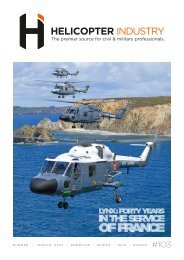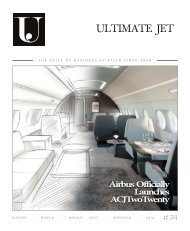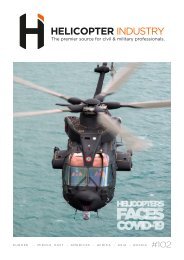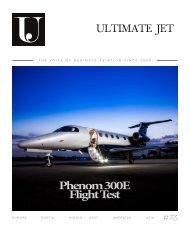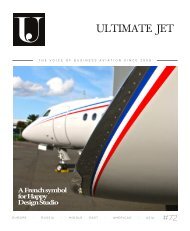Magazine Helicopter Industry #101
- No tags were found...
You also want an ePaper? Increase the reach of your titles
YUMPU automatically turns print PDFs into web optimized ePapers that Google loves.
HELICOPTER INDUSTRY I FLIGHTEST I<br />
R<br />
ight at the time for our rendez-vous, our test machine<br />
is still in flight. It lands in front of us two minutes<br />
later. The passenger, a private pilot invited to discover the<br />
Enstrom 280FX, disembarks.<br />
It’s the very beginning of the afternoon, the weather is calm,<br />
the visibility is perfect. Pilot instructor Christian Guibert<br />
gives his passenger-pilot time to get off and signals his next<br />
guest - your servant - to sit in the left seat, in other words, the<br />
pilot in command’ seat. Indeed, as a three-seater certified<br />
helicopter, the Enstrom has removable flight controls in the<br />
right hand side, in order to offer greater comfort to the other<br />
two passengers.<br />
In this configutration, the pilot, in the left seat, has the<br />
collective lever always under his left hand. This said,<br />
the installation on board does not call for any particular<br />
comment. The main rotor is turning at a respectable height<br />
(2.70 meters) for this category of machine, and the feeling of<br />
security is good while boarding..<br />
CLASSIC, BUT MODERN<br />
INSTRUMENTATION<br />
At the first sight , the cabin looks spacious enough, with<br />
good visibility in all directions. The two windows opened<br />
on the ceiling airframe add light to the already generous<br />
windscreen. The flight deck is immediately attractive.<br />
Designed all in height, its compactness does not obstruct<br />
the pilot’s glance right in front of him, or up and down. The<br />
wide curved bubble augurs comfortable working conditions<br />
especially in aerial photography. Christian Guibert confirms<br />
that, even with the right door removed, no air is coming<br />
inside the cabin.<br />
The seats offer real comfort and seat belts are easy to<br />
fasten. The instrumentation is modern. On the upper part of<br />
the flight deck, the artificial horizon is displayed on a central<br />
digital screen and doubled by an analog instrument located<br />
on the right, close to the screen. The navigation instruments<br />
(heading indicator, VOR, GPS, etc.) come on the lower part of<br />
the flight panel.<br />
The Garmin 650 type GPS navigator is touch-sensitive and<br />
can be even used with gloves. It offers a list of information<br />
that the pilot will select according to his choice - nearest<br />
airfield, nearest VOR, etc. Once the destination point is<br />
entered, the GPS will display it on the screen and deliver all<br />
kinds of useful information: distance and time to destination,<br />
ground speed, and even will calculate of the real wind on the<br />
course. The 280FX is equipped with a flow meter allowing<br />
the pilot to check the remaining autonomy, depending on the<br />
ground speed and the remaining time to destination.<br />
The anemometer is on the left of the screen, the altimeter<br />
and the variometer on the right.<br />
HI I 68




